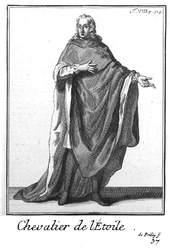Order of the Star (France)

The Order of the Star (French: Ordre de l'Étoile) was an order of chivalry founded on 6 November 1351 by John II of France in imitation of the Order of the Garter founded in 1347 by Edward III of England. The inaugural ceremony of the order took place on 6 January 1352 at Saint-Ouen, from which it is sometimes called the Order of Knights of the Noble House of Saint Ouen.[1]
The order was inspired by the Geoffroy de Charny, theoretician of chivalry. In part it was intended to prevent the disaster of Crécy and to this end only success on the battlefield counted towards a member's merit, not success in tournaments. By its statutes, members also received a small payment and the order provided housing in retirement. They were sworn not to turn their back on the enemy or retreat more than four steps. This last provision cost the lives of ninety members of the order at the Battle of Mauron in 1352, and at the Battle of Poitiers in 1356 cost the king his freedom when many, if not most, of his fellow knights of the Star lost their lives. The Order fell rapidly into disuse during John's captivity in London, but afterwards the nominal ranks swelled so enormously that by the time of Charles V its bestowal was meaningless.

The badge of the order was a collar with a white star on red enamel; the device Monstrant regibus astra viam ("the star[s] show the way to kings") refers to the Three Kings led by the Star of Bethlehem. If an existing manuscript illumination (illustration) depicting the founding meeting of the Order is accurate, the Order's garb consisted in red robes lined with vair bearing eight-pointed black stars set with various gemstones worn on the upper left side of the mantle. The exact size of this star and the number and value of the gemstones with which it was set varied according to the knight's own choice since the star was made at the knight's own expense. The insignia also included a gold ring of which the bezel was circular, enamelled red with an eight-pointed star in white enamel at its center and extending the diameter of the bezel, while the motto of the Order was inscribed on the outside of the ring around this bezel. While the Order itself was short-lived, the use of an eight-pointed star worn on the left breast became very influential in the design of the insignia of many later orders of chivalry and still later orders of merit.
The Order also had a red banner sprinkled with white eight-pointed stars and bearing an image of the Virgin at its center.
References
- Boulton, D'Arcy Jonathan Dacre. The Knights of the Crown: The Monarchical Orders of Knighthood in Later Medieval Europe, 1325–1520. 2nd ed. Woodbridge, UK: Boydell Press, 2000. ISBN 0-85115-795-5
- "Ordre de l'Étoile". Dictionnaire universel d'histoire et de géographie, edd. Marie-Nicolas Bouillet and Alexis Chassang. Paris: Hachette, 1878.
- Ordre de l'Étoile, Orders of Chivalry in France.
- Gustav Adolph Ackermann, Ordensbuch, Sämtlicher in Europa blühender und erloschener Orden und Ehrenzeichen. Annaberg, 1855, p 209 n°86 "Orden Unserer liebe Frau von dem edlen Haus" or "Sternorden" - Google Book (Former orders of France : p. 205-214)
Notes
- ↑ In French the order was initially called les Chevaliers de Nostre Dame de la Noble Maison ("the Knights of Our Lady of the Noble House"). In Latin the order was referred to in early documents as consortium seu societatem militem Beate Marie Nobilis Domus apud Sanctum Odoenum prope Sanctum Dyonisium in Francia ("the knightly company or society of the Blessed Mary of the Noble House at Saint-Ouen near Saint-Denis in France") in a letter founding its canonical institute, and inclite Stellifere Congregationis nostre militaris apud Sanctum Audoenum in Domo Nobili ("illustrious Starbearing Knightly Congregation in the Noble House at Saint-Ouen") in a letter of June 1356, from Ursula Georges, Medieval Names of Some Knightly Orders.
- ↑ Maximilien Bullot & Pierre Hélyot, "Histoire des ordres monastiques, religieux et militaires, et des congregations seculieres de l'un & l'autre sexe, qui ont esté establies jusque'à present", Engravings by François de Poilly, Ed. Nicolas Gosselin, Paris, 1719, 8th Tome, - Google Book : 6th Part, p 308